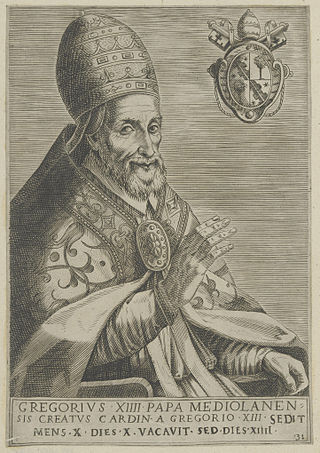
Pope Gregory XIV, born Niccolò Sfondrato or Sfondrati, was head of the Catholic Church and ruler of the Papal States from 5 December 1590 to his death, in October 1591.

Francesco Foscari was the 65th Doge of the Republic of Venice from 1423 to 1457. His reign, the longest of all Doges in Venetian history, lasted 34 years, 6 months and 8 days, and coincided with the inception of the Italian Renaissance.

Andrea Mantegna was an Italian painter, a student of Roman archeology, and son-in-law of Jacopo Bellini.

Francesco Primaticcio was an Italian Mannerist painter, architect and sculptor who spent most of his career in France.
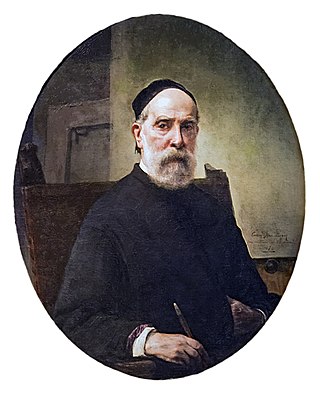
Francesco Hayez was an Italian painter. He is considered one of the leading artists of Romanticism in mid-19th-century Milan, and is renowned for his grand historical paintings, political allegories, and portraits.

Francesco Melzi, or Francesco de Melzi (1491–1570), was an Italian painter born into a family of the Milanese nobility in Lombardy. He became a pupil of Leonardo da Vinci and remained as his closest professional assistant throughout his career. After da Vinci's death he became the literary executor of all da Vinci's papers, editing them into a manuscript on painting he published as Tratatto della Pittura [Treatise on Painting] or a compilation entitled the Codex Urbinas.

Vincenzo Foppa was an Italian painter from the Renaissance period. While few of his works survive, he was an esteemed and influential painter during his time and is considered the preeminent leader of the Early Lombard School. He spent his career working for the Sforza family, Dukes of Milan, in Pavia, as well as various other patrons throughout Lombardy and Liguria. He lived and worked in his native Brescia during his later years.

The Castello Sforzesco is a medieval fortification located in Milan, Northern Italy. It was built in the 15th century by Francesco Sforza, Duke of Milan, on the remnants of a 14th-century fortification. Later renovated and enlarged, in the 16th and 17th centuries it was one of the largest citadels in Europe. Extensively rebuilt by Luca Beltrami in 1891–1905, it now houses several of the city's museums and art collections.
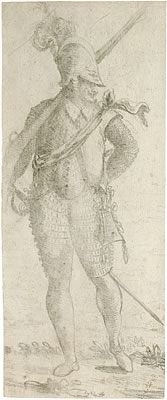
Giovanni Contarini (1549–1605) was an Italian painter of the late Renaissance.

Filippo Abbiati (1640–1715) was an Italian painter of the early-Baroque period, active in Lombardy and Turin, together with Andrea Lanzani and Stefano Maria Legnani, he was a prominent mannerist painters from the School of Lombardy. Born in Milan, he was a pupil of the painter Antonio Busca. Alessandro Magnasco was one of his pupils along with Pietro Maggi and Giuseppe Rivola. Ticozzi claims he trained, along with Federigo Bianchi, with Carlo Francesco Nuvolone. Along with Bianchi, he painted the cupola of Sant'Alessandro Martire in Milan. Abbiati also painted a St. John preaching in the Wilderness for a church in Saronno.

Giulio or Giuliano Traballesi or Trabellesi was an Italian designer and engraver.

The Marriage of the Virgin, also known as Lo Sposalizio, is an oil painting by the Italian High Renaissance artist Raphael. Completed in 1504 for the Franciscan church of San Francesco, Città di Castello, the painting depicts a marriage ceremony between Mary and Joseph. It changed hands several times before settling in 1806 at the Pinacoteca di Brera.
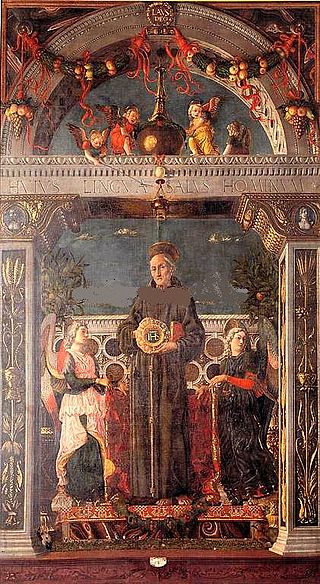
St. Bernardino of Siena between Two Angels is a painting attributed to the Italian Renaissance artist Andrea Mantegna and his assistants, dated to 1460 and housed in the Pinacoteca di Brera of Milan.
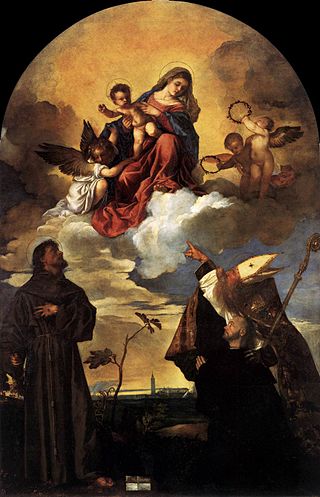
The Gozzi Altarpiece is an oil painting by the Italian Renaissance master Titian, dating from 1520. It is located in the Pinacoteca civica Francesco Podesti in Ancona, central Italy.

The Madonna della Vittoria is a painting by the Italian Renaissance painter Andrea Mantegna; the painting was executed in 1496.

Bernardino de 'Conti was an Italian Renaissance painter, born in 1465 in Castelseprio and died around 1525.
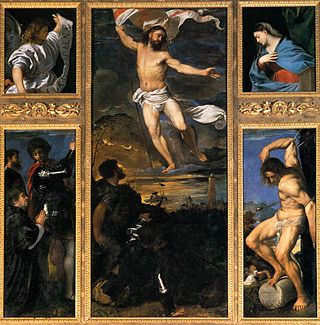
The Averoldi Polyptych, also known as the Averoldi Altarpiece, is a painting by the Italian Renaissance painter Titian, dating to 1520–1522, in the basilica church of Santi Nazaro e Celso in Brescia, northern Italy.

Vanity is an oil painting by the Italian late Renaissance painter Titian, dated to around 1515 and now held at the Alte Pinakothek in Munich, Germany.
The Introduction of the Cult of Cybele at Rome is a painting in glue tempera on canvas by Andrea Mantegna. Measuring 73.5 cm by 268 cm, It was produced in 1505–1506 and is now in the National Gallery in London. Like much of Mantegna's output after 1495 it is in monochrome, linked to contemporary sculpture and also part of the trend for illusion and trompe-l'œil favoured by the Mantuan court and especially by Isabella d'Este.

Madonna della Consolazione is an oil on panel painting by Perugino, datable ca. around 1496–1498. The work, completed in April 1498, was carried out in the Sala delle Udienze of the Collegio del Cambio. Since c. 1820 it is preserved in the National Gallery of Umbria in Perugia.


















